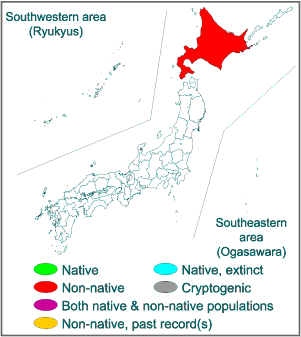
 Japanese |
English
Japanese |
English- Invasive Species of Japan >
- Insects >
- Bombus terrestris
| Invasion information | ||
| Range in Japan | Established in entire Hokkaido. In several other prefectures, there have been records of observation and nesting. |

|
| Origin | Imported from Netherland, Belgium, etc. | |
| Date | Imported since 1992. The first record of feral nest in Japan was in 1996 at Monbetsu, Hokkaido. | |
| Route | Deliberate: Escape from agricultural use for pollination (greenhouse tomato, etc.). | |
| Impact | Competition (for nesting sites and plant use) with and reproductive interference to native Bombus. Inter-specific copulation with some native species result in inviable offsprings. Prohibition of pollination of some native plants by nectar robbing. Having parasitic mite (Locustacarus buchneri). Native organism(s) affected: There are several native Bombus in Hokkaido. Several plants pollinated by native bumblebees (e.g., Corydalis ambigua). | |
| Regulation in Japan | Import, transport and keeping are prohibited in Japan by the Invasive Alien Species Act. Agricultural use in Japan is permitted only in greenhouses with prevention of escaping by covering apertural part using net. | |
| Introduced range in other countries | North America, Oceania, Israel, etc. | |
| Reference | Notes |
|
100 of the Japan's Worst Invasive Alien Species
A Japanese species B. ignitis has become popular for agricultural use, instead of B. terrestris. In Hokkaido, there is a monitoring activity for this species and native bumblebees by a citizen network. |